Birds
Media
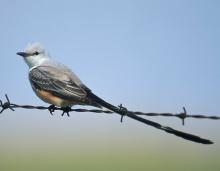
Species Types
Scientific Name
Tyrannus forficatus
Description
One of Missouri’s most breathtaking birds, the scissor-tailed flycatcher captures insects in midair, then flits back to its perch. You’re most likely to see it in summer, in our southwestern prairies.
Media
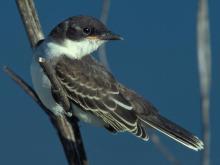
Species Types
Scientific Name
Tyrannus tyrannus
Description
The eastern kingbird’s spirited territorial defense, tidy, black-and-white plumage, and distinctive, fluttery flight have long captured the attention and admiration of people.
Media

Species Types
Scientific Name
Charadrius vociferus
Description
The killdeer is a familiar “shorebird,” but we usually don’t see it near shores! Killdeer prefer open, flat, rather dry areas with short grass, including flooded crop fields, lawns, and sports fields.
Media
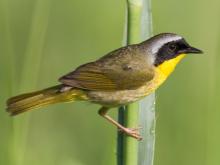
Species Types
Scientific Name
Geothlypis trichas
Description
The male common yellowthroat wears a black mask that contrasts strongly against the bright yellow underparts. The female is olive brown. A common summer resident in Missouri’s marshes and other wet areas.
Media

Species Types
Scientific Name
Scolopax minor
Description
This remarkable bird is a short-necked, short-legged, terrestrial shorebird with a long bill. The eyes are set back on its head. When this bird is flushed, its short wings make a startling whirring sound.
Media

Species Types
Scientific Name
Meleagris gallopavo
Description
The large size, iridescent bronze plumage (which can look merely dark at a distance), and naked blue and red head distinguish this ground-dwelling bird from others in our state.
Media
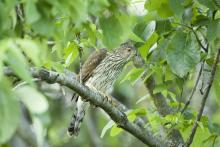
Species Types
Scientific Name
Accipiter cooperii
Description
Cooper's hawks have short, rounded wings and long, narrow, rudderlike tails. They are frequently seen foraging along hedgerows and brush-entangled fencerows.
Media
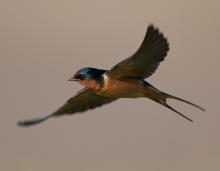
Species Types
Scientific Name
Hirundo rustica
Description
Streamlined, agile fliers with forked tails, barn swallows build cup-shaped nests out of mud affixed to protected areas on the walls of barns and under bridges.
Media

Species Types
Scientific Name
Petrechelidon pyrrhonota
Description
Cliff swallows fly in swarms around their clusters of juglike mud nests attached to overpasses, bridges, and other structures. Note the whitish forehead, buffy rump patch, and chestnut throat.
Media

Species Types
Scientific Name
Quiscalus mexicanus
Description
The great-tailed grackle occurs mostly in western parts of Missouri, which is on the northeastern edge of its range. This blackbird’s long, V-shaped tail is distinctive, as is its song of whistles, clacks, chucks, and clicks.
See Also







Media

Species Types
Scientific Name
Hemaris diffinis
Description
The snowberry clearwing is a moth that confuses people because it looks like a bumblebee and flies like a hummingbird!
Media

Species Types
Scientific Name
Hyles lineata
Description
The white-lined sphinx moth sometimes confuses people because it flies, hovers, and eats from flowers like a hummingbird. The adults often fly during daylight hours as well as in the night and are often found at lights.
Media

Species Types
Scientific Name
Darapsa myron
Description
The Virginia creeper sphinx moth is common in woods and brushy areas and comes to lights at night. The larvae eat Virginia creeper and grape leaves.
Media

Species Types
Scientific Name
Perimyotis subflavus (formerly Pipistrellus subflavus)
Description
Tri-colored bats, formerly called eastern pipistrelles, are relatively small and look pale yellowish or pale reddish brown. The main hairs are dark gray at the base, broadly banded with yellowish brown, and tipped with dark brown.
Media

Species Types
Scientific Name
Myotis grisescens
Description
Gray myotises are difficult to distinguish from other mouse-eared bats. A key identifying feature of the gray myotis is that its wing is attached to the ankle and not at the base of the toes. It’s an endangered species.
Media

Species Types
Scientific Name
Myotis lucifugus
Description
The little brown myotis (little brown bat) is one of our most common bats, but populations are declining. White-nose syndrome has taken a heavy toll in northeastern states. This species is now listed as vulnerable across its range.
Media

Species Types
Scientific Name
Myotis sodalis
Description
The Indiana myotis, or Indiana bat, summers along streams and rivers in north Missouri, raising its young under the bark of certain trees. It is an endangered species.
About Birds in Missouri
About 350 species of birds are likely to be seen in Missouri, though nearly 400 have been recorded within our borders. Most people know a bird when they see one — it has feathers, wings, and a bill. Birds are warm-blooded, and most species can fly. Many migrate hundreds or thousands of miles. Birds lay hard-shelled eggs (often in a nest), and the parents care for the young. Many communicate with songs and calls.





















